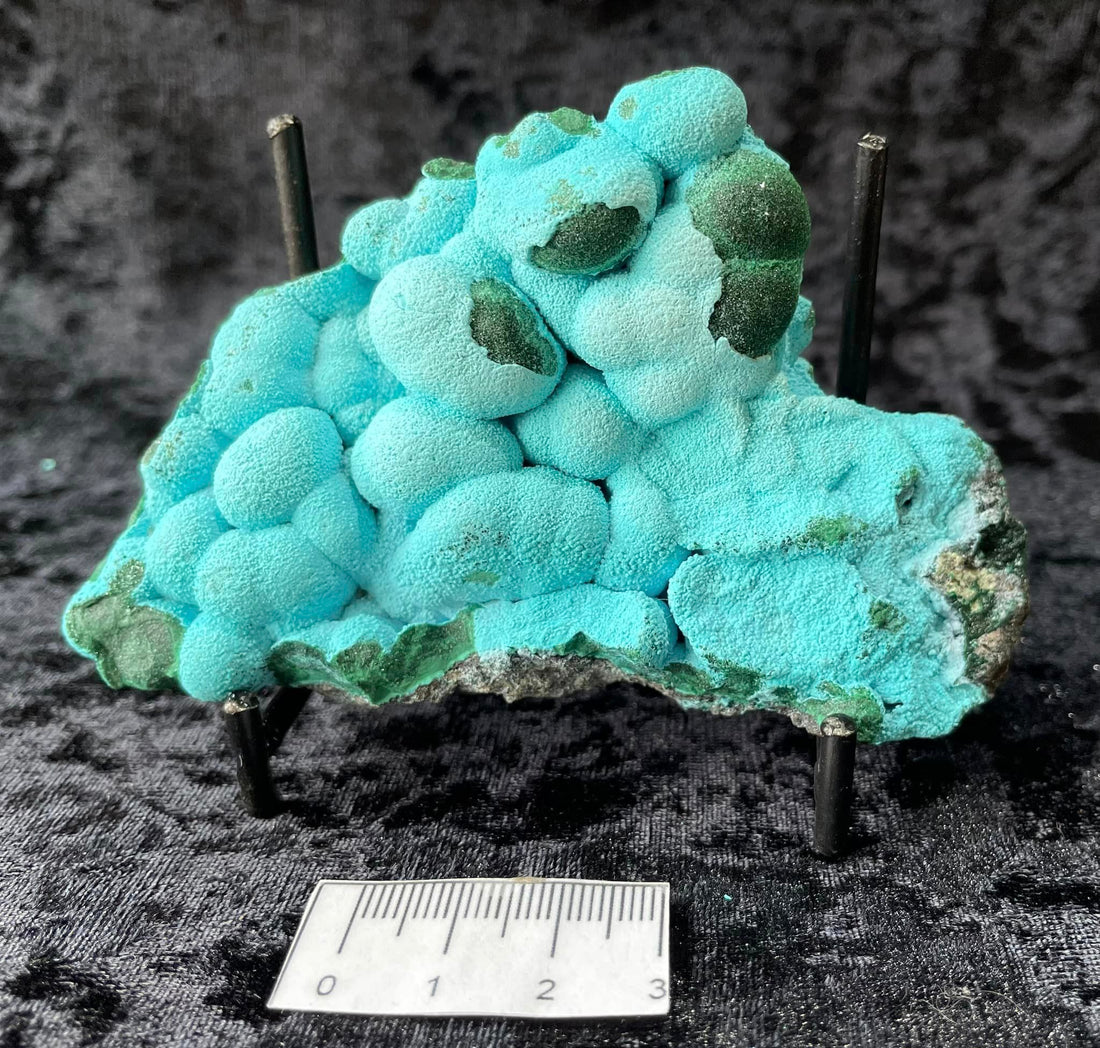
Chrysocolla: A Comprehensive Scientific Overview
Share
Chrysocolla is a captivating mineral known for its vibrant blue-green hues and its association with copper deposits. This mineral has intrigued geologists and gem enthusiasts alike due to its unique properties and formation processes. In this blog, we will delve into the scientific aspects of chrysocolla, exploring its chemical composition, physical properties, formation, and geological significance.
Chemical Composition and Structure
Chrysocolla is a hydrous copper phyllosilicate mineral with the chemical formula ((Cu, Al)_2H_2Si_2O_5(OH)_4 \cdot nH_2O). The presence of copper gives chrysocolla its characteristic blue and green colors. The formula indicates that chrysocolla contains copper (Cu), aluminum (Al), silicon (Si), oxygen (O), hydrogen (H), and water molecules (H_2O). The “n” in the formula represents the variable amount of water present, which can vary from specimen to specimen.
Physical Properties
Chrysocolla exhibits a range of physical properties that make it easily identifiable, including it's crystal system.
Orthorhombic Crystal System: This refers to one of the seven crystal systems in which minerals can form. In the orthorhombic system, the crystal structure is characterized by three mutually perpendicular axes that are of unequal lengths. Imagine a rectangular prism where the lengths of the sides are all different.
Amorphous Formation: When a mineral forms amorphously, it means that it lacks a well-defined crystal structure. Instead of having an orderly and repeating pattern of atoms, the atoms are arranged randomly. This can happen when the mineral cools down too quickly, preventing the formation of a crystalline structure.
So, when we say “Crystal System: Orthorhombic, though it typically forms amorphously,” it means that while chrysocolla can theoretically form in the orthorhombic crystal system, it usually doesn’t develop a well-defined crystal structure and instead forms in a more disordered, amorphous state.
Additional physical properties of Chrysocolla are:
- Color: Blue, cyan, green, dark blue to black, and rarely yellow.
- Luster: Vitreous to dull.
- Transparency: Translucent to opaque.
- Hardness: 2.5 to 3.5 on the Mohs scale, but can reach up to 7 when heavily silicified.
- Specific Gravity: 1.9 to 2.4.
- Cleavage: None.
- Fracture: Irregular/uneven, sub-conchoidal.
Formation and Occurrence
Chrysocolla forms as a secondary mineral in the oxidation zones of copper ore deposits. It is commonly found in association with other secondary copper minerals such as malachite, azurite, and cuprite. The mineral typically occurs in botryoidal or crust-like masses, as well as in fibrous or vein-like structures.
Let’s expand on that:
Botryoidal or Crust-like Masses: Chrysocolla often forms in botryoidal masses, which means it has a rounded, grape-like appearance. This texture occurs when the mineral grows around numerous nuclei, such as specks of sand or dust, resulting in a cluster of small, rounded segments. Additionally, chrysocolla can form crust-like masses, where it spreads out in a thin layer over the surface of rocks.
Fibrous or Vein-like Structures: In some cases, chrysocolla can develop in fibrous structures, where the mineral forms in fine, hair-like crystals that are parallel or radiate outwards. It can also occur in vein-like structures, filling cracks and fractures in rocks. These veins are formed by the deposition of mineral-rich fluids within the fractures, leading to the growth of chrysocolla along the walls of the veins.
Chrysocolla is commonly found in arid or semi-arid regions where copper deposits are prevalent. These areas often have the right conditions for the formation of secondary copper minerals. In arid regions, the weathering and oxidation of copper sulfide minerals lead to the formation of chrysocolla and other copper oxides. The mineral is typically found near the surface, where acidic groundwater filters through the rocks, accumulating copper minerals.
Geological Significance
Chrysocolla is a minor ore of copper and is of secondary origin. It forms in the oxidation zones of copper ore bodies, making it an important indicator of copper deposits. Its presence can help geologists locate and assess the potential of copper mining sites. Additionally, chrysocolla’s vibrant colours and unique properties make it a valuable gemstone and ornamental material.
Uses and Applications
Due to its attractive colours, chrysocolla has been used as a gemstone for carvings and ornamental purposes since antiquity. It is often used in silversmithing and goldsmithing in place of turquoise. Chrysocolla chalcedony, a heavily silicified form of chrysocolla, is particularly valued for its hardness and beauty.
Chrysocolla is a fascinating mineral with a rich history and significant geological importance. Its unique chemical composition, physical properties, and formation processes make it a subject of interest for both scientists and gem enthusiasts. Whether used as an indicator of copper deposits or as a beautiful gemstone, chrysocolla continues to captivate and inspire.
References
- Wikipedia: https://en.wikipedia.org/wiki/Chrysocolla
- Geology Science: https://geologyscience.com/minerals/silicates-minerals/chrysocolla/
- Britannica: https://www.britannica.com/science/chrysocolla